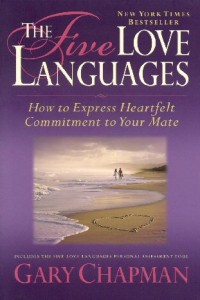 Imagine falling in love with someone who speaks a language in which you are not fluent or do not understand. How would you share and communicate about important subjects? How would you communicate your love? Consider the stereotype of the person that speaks more loudly when trying to communicate to someone who does not share a common language. It does not matter how loudly you speak Tagalog, I will not understand what you are trying to say with only your words. Gary Chapman, author of “The Five Love Languages,” has written a very popular series of books based on the idea of five basic ways that we communicate love with others. We use these languages to communicate caring and affection for everyone in our lives, partners, family, and friends.
Imagine falling in love with someone who speaks a language in which you are not fluent or do not understand. How would you share and communicate about important subjects? How would you communicate your love? Consider the stereotype of the person that speaks more loudly when trying to communicate to someone who does not share a common language. It does not matter how loudly you speak Tagalog, I will not understand what you are trying to say with only your words. Gary Chapman, author of “The Five Love Languages,” has written a very popular series of books based on the idea of five basic ways that we communicate love with others. We use these languages to communicate caring and affection for everyone in our lives, partners, family, and friends.
He writes that each of us has a primary language through which it is easiest for us to both communicate and understand love. Communication flows easily when both parties are fluent in the language used; however, at times, we must utilize a language that may be more difficult to to ensure that the message is easily understood or learn to recognize and understand the basics of a language that is being spoken to us.
Spanish is my second language. I am fairly accurate at understanding when a friend writes emails in Spanish; however, I may miss nuances. My use of the language, however, is likely frustrating to her with my basic grammar. If you are trying to use a love language that is difficult for your partner (or friend or child) to understand, it will not matter how loudly you speak. On the other hand your partner (or friend or sibling) may be continuously trying to communicate love to you; however, you are not familiar with the language they are utilizing. Healthy communication requires responsibility for both clear expression and clarification of understanding. To determine what your primary and secondary love languages are you may want to take this quiz.
Words of Affirmation could be compliments, encouragement, or descriptions of your love. These words can be communicated in both written and verbal forms.
Quality Time is focused attention and shared thoughts. Simply sharing an activity is not quality time if there is not engagement with the other. Discussion and communication can be an important part of quality time.
Acts of Service include any task that may make things easier for the one to whom you are trying to communicate. Errands or chores such as taking out the trash, folding the laundry, or packing a healthy lunch can be acts of love.
Receiving Gifts can be a tangible symbol of love because gifts often communicate thoughtfulness.
Physical Touch can include any type of affectionate touch that is appreciated by the recipient. Touch is important for our survival and can be soothing, stimulating, or comforting.

Great idea for a blog post on Valentine’s Day, Brooke.
This is an excellent book that will improve most marriages along with relationships with other close relatives, such as your children. It can also explain odd behavior in acquaintances!
Highly recommended.
-Steve Parker, M.D.
As far as learning another language, is concerned, can I put in a word for the international language, Esperanto?
Although Esperanto is a living language, it helps language learning as well.
Five British schools have introduced Esperanto in order to test its propaedeutic values. The pilot project is being monitored by the University of Manchester and the initial encouraging results can be seen at .
An interesting video can be seen at, Professor Piron was a former translator with the United Nations
A glimpse of Esperanto can be seen at.
this is a great book, i highly recommend it for anyone in a relationship or wanting to be in one…..it is right on with the information….if you are wanting to manifest a soulmate here is a suggestion:
Here is a great opportunity to get a celebrity video presented by Arielle Ford promoting her book The Soulmate Secret, produced by Darlene Siddons, Vision Map Videos
darlene
Thank you for the comments. This is a good theory that is easy for people to understand, easy to apply to your relationships, and can make a major impact. I use it frequently when working with clients because they enjoy it so much.